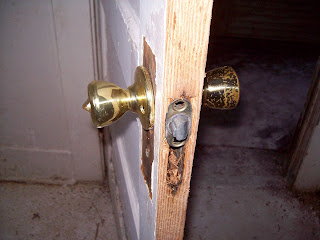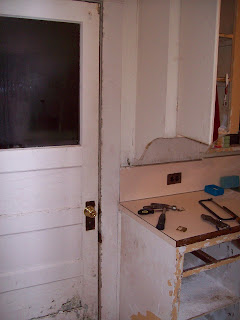My garage that is. When it rains much I get this little stream flowing behind my bed/couch in earthen gap between wall footing and slab. Hasn't gotten worse yet. Carpet permanently folded under futon, bedding tucked securely 'tween mattress and frame this side of bed to not drag in water, bed tight against wall so comforter and other bedding can't fall into my little interior water feature - raises property value doesn't it? - when I rustle 'round at night. Still no trouble sleeping - this morning I slept in a bit. Dry so bike rode couple miles to Jerry's - locally owned Home Depot competitor - to check stove pipe prices. Lime gone now and removing a couple sheets of 1/4" underlayment will make me ready to hook up wood stove. Surprisingly they were a bit more expensive. Rain came up but I rode on to Winco to stock up on bulk items - primarily lentils and peanuts - and home in rain. I'll buy stovepipe closer to home after checking a wood stove devoted shop near the house. All researched I may save $5 - not much but I'll use the dough else where and be satisfied it couldn't be done much cheaper.
Four inch putty knife along with drywall blade:
primary scraping tools. Might use screwdriver in a pinch. Putty knife has angled edge - pretty obvious in this photo - making long side good for corners. Scraping moves fair amount of material quickly - especially with drywall blade.
Started in front east bedroom - here before scraping -
and after.
While working I decided to do a basic prep job on all surfaces - not just floor. Remove extraneous metal - picture hangers, drapery rod hardware, phone jacks, etc. - scrape walls and ceilings. If a surface remained essentially unchanged we'll by pass it this tour. Starting to look possibly livable. Scraping revealed a few rotten areas on floor in this room but
walls and ceiling in pretty good shape though south and east walls were bad enough to be covered with sheetrock at some time. That'll go eventually. Time will tell how much rot lies beyond the floor. Moving to middle bedroom (before)
I deploy my arsenal. Dust raised by scraping in photos shows I'm not posing for camera - real work is going on. Note drywall blade in one hand putty knife in other.
Result.Paint stripper here and I might even avoid sanding though this room's floor may end up donor to repair floor elsewhere replaced with carpet and underlayment. Walls and ceiling not too bad in middle room but rot in kick board on outside wall - don't want to know what's hidden.
Next hallway to throne scraped - lime piled for removal in front of middle bedroom door.
Some loose stuff on hall walls and ceiling but nothing remarkable. The big kahuna - front room - next. Walls in pretty bad shape here. Front west before.
From front door clockwise 'round the room.
Good view of wood pile waiting on front porch. Love those windows.
Front west after.
Chimney I removed four gallons soot from upper right in this photo. Moisture from chimney probably responsible for most damage here.
That completes tour of wall damage in front room preliminary prep done. Some areas will need new cement on lathe, most will require skim coat with plaster - that's down the road a piece.
Walls finished, scrapings sent off to dump, I go after floor - the most aerobic thing I've done in a while and I do quite a few.
Ready to remove 1/4" underlayment. Then in goes stove.
Kitchen next. West wall and back door change visually and become more odor free.
Here monkey like scraping kitchen cupboards. Lime scraped off carried odor with it. One's nose close to surface gives a whiff but overbearing stench largely gone - I'm calling it 95% gone. Scraping every surface cleans things up too.
Weapons next to used lime repository - a kitchen drawer. I debated but ultimately spread lime on garden.
Making this floor ready for underlayment removal too.
Entire house interior now preliminary prepped excluding bath which first I will remove built in cupboards from.
Back door closing well decided me to go ahead with knob/lock. Old time doors had a lock using skeleton key.
That fit into slot in recently ripped door
like this. When installed it was flush with door edge latch only protruding.
New lock set with two keys put together from pieces in parts bin, paid 50 cents for at ReStore needs large hole through door. Out come cordless drill and big spade bit.
Slot needs to be enlarged with 'chisel'.
Now new latch goes in OK.
Test fitting shows hole in door needs to be larger.
With keyhole saw and 'chisel' make like beaver.
All fits proper now.
Latch has plate that screws to door so fill slot with tight fitting wood scraps to take screws.
Screws holding knobs together too long, Cut halfway with hack saw, break with vise grips and pliers, file so they'll thread into knob well.
Installed lock set covers beaver gnawings. Putty and paint will complete job. Outer keyed knob.
Inside knob.
Old striker plate comes off.Chisel to allow new striker.
Of course it wasn't this simple in real life but ultimately back door closes. latches, locks nicely.
Now when I dismantle back porch I can lock the house. I'll talk about refuse removal and we'll take a look up chimney in preparation for installing stove next time. Peace d






















































you are Amazing.. truly... you want to get something done, that's quite frankly in most of your instances there, very difficult and you somehow, work with little, and still Achieve...! v
ReplyDeleteYou are making a lot of progress. You are doing a terrific job of documenting it.
ReplyDeleteI noticed you were not wearing a face mask while you were scraping. Was that just for the picture? I do hope you are wearing one. Do you have to worry about lead paint when you scape, and inhaling it? I can see putting lime on the garden, but if there are paint scrapings mixed in it, will it contaminate the soil? Does Oregon have an Extension Service ( Ag) you can consult? we have one here where I live.
Wore mask for most dusty work. Thx. Minor amount of paint chips with lime perhaps some lead - why I debated. Decided plants will metabolize small amounts but I'm no expert. Bulk of paint scraps went to dump.
ReplyDeleteI think there is some kind of test kit (to see if there is lead in the paint) sold at hardware stores. When I did Public health nursing we ran into kids with lead poisoning. They usually lived in old houses with peeling paint. So glad to hear you are wearing a mask.
ReplyDelete